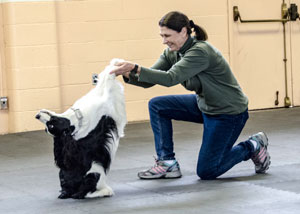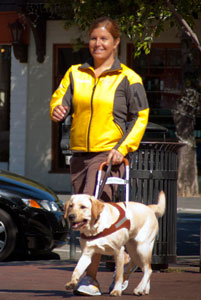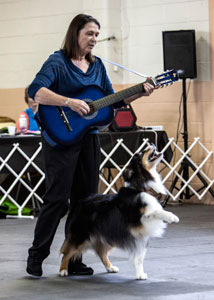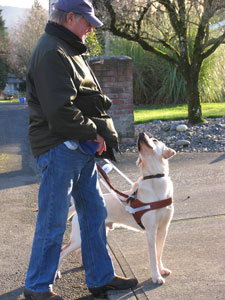Originally published 3/5/2013 and recently updated 6/21/2016.
Editor's note:
Karen Pryor Academy (KPA) and ClickerExpo faculty member Michele Pouliot is the winner of multiple national and international freestyle competitions, including the World Canine Freestyle Organization (WCFO) World Championship in 2009. In November 2008, Michele and her dog Listo made WCFO history as the first team to receive perfect "10s" for both Artistic and Technical scores in the Championship division of Perfect Dance Partners. Michele and Listo repeated this benchmark of "double 10s" for a total of 25 times!

Listo has passed away, but Michele has continued her canine freestyle competition with Déjà vu, a 6-year-old English springer spaniel, and Saké, a 3-year-old Australian shepherd. Déjà vu has achieved four Championship titles in canine freestyle, while Saké has begun his competition career by winning Highest Technical and Artistic scores from the Novice Division.
Michele continues to make an impact in the dog world. As the Director of Research and Development for Guide Dogs for the Blind (GDB), Michele has led the organization through a gradual changeover from traditional training to clicker training in guide dog work. She now works with GDB to actively support and assist other guide dog schools in their efforts to adopt clicker training.
Michele was honored recently with a lifetime achievement award from the International Guide Dog Federation (the Ken Lord award). The award recognizes Michele's promotion of and support to guide dog schools around the world in the adoption of positive reinforcement and clicker training techniques. This award has only been presented to seven recipients; it is the highest form of recognition from colleagues in the international canine freestyle community. This most recent international conference in Croatia (where the award was presented) hosted more than 300 guide dog instructors from all over the world. "I was overwhelmed with the amount of recognition I received from so many schools over my impact on our industry," says Michele.
Great strides are being made in the guide dog industry; here Michele shares some of her strategies, hoping to help others who wish to effect change in their own organizations. Michele also describes some powerful elements of clicker training that many trainers may not take advantage of currently.
You led the successful changeover from traditional training to clicker training at Guide Dogs for the Blind. What was the catalyst for that change?

Clicker trained guide dog
Although we had a successful program that provided safe and effective guide dogs for blind individuals, several factors prompted Guide Dogs for the Blind's initial decision to adopt clicker training. The strong desire to be more successful with dogs with more sensitive temperaments was significant. We were serving an increasingly aging population of blind people who benefited greatly from a type of dog that is more easily managed, more sensitive in nature. This type of dog was rarely successful in our traditional training program, as the techniques in that program did not develop confidence in performing guide dog work in that group of dogs. To serve our changing client population effectively, it became clear that there was a need for dogs with more sensitive temperament, which created a need for alternative training.
In addition, the working environment for guide dogs had become progressively more difficult since the 1990s; this truth was often lamented in conversations among guide dog trainers worldwide. As the years passed, working environments became increasingly difficult for guide dogs to navigate. Examples of environmental challenges included an increased number of encounters with "less than friendly" humans on the street, more free-running dogs (often aggressive), higher volume vehicle traffic, increased pedestrian traffic, and louder noise volume. It became essential to address the question of how to make the job of a guide dog in the modern world more positive and less stressful.
A more positive way of developing guide dogs was viewed as a potential way to resolve some of these challenges that our guide dog program and others like it were experiencing.
How has the guide dog industry changed since then?
Since Guide Dogs for the Blind led the way in adopting a clicker-training-based program in 2006, we have seen more guide dog schools around the world open their minds to positive training methods. Our success in applying clicker training to guide dog work has made a huge impact on the guide dog industry. At the very least, we have encouraged schools to think outside the box; at best we have seen several schools make the commitment to adopt clicker training fully as the way to train guide dogs.
We have hosted several International Clicker Conferences for guide dog schools at our Oregon campus. The first conference was in 2006; since 2009, conferences have been held every other year. The goal of each conference has been to assist schools in learning how to clicker train guide dogs effectively.
These week-long conferences have been very exciting. They have allowed us to provide schools with the "light bulb moments" that are so necessary in motivating people to go through major change. Guide Dogs for the Blind has been directly involved in supporting more than a dozen guide dog schools in their crossover to clicker training, including schools in Canada, Australia, Switzerland, Israel, Germany, Japan, the United Kingdom, Korea, and the United States.
The change in the industry overall will be long-term, but eventually most schools will cross over as they witness the success in other programs and as they get more requests for positive training from their own client base.
What is your advice to others who want to promote change within their own organizations?
Be a "positive" changemaker. That might sound redundant if you are envisioning a positive reinforcement dog trainer wanting to help traditional trainers change over to clicker training. Unfortunately, the reality is that over the past 18 or so years I have experienced many positive animal trainers with very punishing attitudes toward traditional human trainers. For this reason, it took my guide dog school more than 10 years to reconsider the idea of food-reward training after we expressed initial curiosity about clicker training. Our first efforts to find out about positive methods were met with criticism and harsh judgments about our existing methods.
Believe me, that is not how you inspire traditional trainers to open their minds to positive-based training. Changing from methods a trainer is experienced with and confident of is very difficult and requires ongoing success with the new techniques. Speaking up within one's own organization requires tact and compassion for how challenging simply thinking outside of the box will be. Starting with letting people witness and then experience the power of clicker training is my "go to" method of initiating interest.
The larger a program is (higher numbers of staff), the longer and more challenging crossing over to clicker training is likely to be. Established organizations need motivation to change; they need to realize how these techniques will work effectively for their program needs. General, less specific reasons to change (for example, "to be positive") do not provide the same incentive. It is imperative that trainers receive ongoing motivation, and inspiration that keeps them learning the new skills that are very different from the skills they know, trust, and have mastered.
The next important piece of advice is patience. Change takes time. Although it is important to be active in motivating the progress toward change, accept that it does take time to educate experienced trainers in very new skills. I have become much more patient over the last 10 years and have learned that patience (along with being supportively persistent) does pay off in progressing toward the goal.
What are some challenges a changemaker might face, and what's the best way to overcome those challenges?
Expect individuals to revert to methods they are fluent in when they have difficulty making new techniques work. When clicker training is not working, new students need support and specific help with how to be effective using techniques foreign to them.
We experienced instances where individuals (who were quite open to change) were not seeing instant results in training a specific behavior and wanted our program to revert back to traditional punishment "just for that subject." An instance like that is the perfect time for answers, not criticism. When training progress encounters an obstacle, individuals need specific answers and guidance for reaching the goal behavior they seek.
For an organization going through change, having outside experts as consultants is invaluable. It is essential that the experts are a good fit for that organization overall. They must be patient and supportive while motivating the program to continue the process of change and evolution. Sometimes this means waiting to tackle some traditional training subjects at a later date, and not attempting to change everything at once.
At ClickerExpo, you often talk about strategic reinforcement delivery. What is strategic reinforcement delivery?
Strategic reinforcement delivery means intentionally delivering the reward in a location and/or style that benefits the training of the behavior. The click very powerfully communicates to the animal "what" is being rewarded. The reward delivery method and location can greatly influence the accuracy and value of that communication. Strategic reward delivery can speed up an animal's learning and enthusiasm for learning—it's a powerful element of clicker training that many trainers are not taking advantage of.
How has incorporating strategic reinforcement delivery helped in your own work with dogs, both as a guide dog trainer and as a freestyle champion?
Top trainers are often using brilliant reward strategies without even realizing they are doing so, simply because they are responsive to their dogs. Each year the dogs I work with teach me more about the power in strategic reward delivery. An animal's reactions following the marker, during reward delivery, are very revealing and should be noted.

Michele and Listo
In freestyle training, I found a simple example in training distance responses. In 2007, I was working on a new distance behavior with my Australian shepherd, Listo. The behavior was duration backing away from me across the entire ring (about 50+ feet) until cued to stop. Although I was marking "active backing" effectively, increasingly Listo was slowing down during this behavior. The look of excitement on his face upon hearing the click was clear; just as clear was his excitement to run to me for his reward after the click.
Bingo—a light bulb moment for me. I was creating an expectation in Listo that he would be running forward for reward, which was in direct opposition to my goal behavior. As soon as I started rewarding each "backup click" in a location behind Listo, presto! Listo backed up faster. Listo taught me the importance of location when rewarding distance behaviors, resulting in much more powerful training of all my distance behaviors.
In guide dog work, the majority of food rewards are delivered via stationing. The guide dog remains in a working position (similar to a forged heel position) for reward delivery in order to aid a blind handler's orientation in the environment. When a guide dog hears a click while guiding, the dog remains in guide position. In this way the dog does not disorient the blind person by facing another direction to receive the reward. During guide dog training, dogs become quite adept at demonstrating excitement about the coming reward while at the same time waiting for the handler to deliver food directly to a stationed position.
What are some considerations for adding reinforcement strategy into training?

Guide dog stationing for reward delivery
The idea is for the reinforcement delivery to assist the animal in learning or maintaining a behavior. Some examples of strategic reinforcement goals could be: increase or decrease an individual animal's energy in performing a behavior, deliver the reward in a location that resets the animal for a successful next repetition, and/or deliver the reward in a location that supports the end-goal behavior (often not resetting the animal for another repetition).
What are some keys to effective reinforcement strategy?
- Planning a delivery strategy that best supports your goal for a training session
- Recognizing when a method of delivery is hindering training so that you can adjust delivery method to accelerate progress
- Becoming consciously aware of what delivery method is in use, and how it may be affecting training
- Utilizing a variety of reinforcement strategies as they relate to different behaviors being trained
In the many years that you have been a presenter at ClickerExpo (how many years has that been?), what was your own "WOW" moment?
I was invited to join the ClickerExpo faculty in 2007, so I am personally celebrating "10 years of WOW." Before joining the faculty, I attended two ClickerExpo conferences and experienced the "WOW" of being in the audience.
Being a part of this incredible group of professionals has been so impactful on my training career; it is hard to put it all into words. I continue to learn amazing things from my Expo faculty colleagues every year, and am very thankful for the opportunities to collaborate with talented mentors and associates.
I don't have just one "WOW" ClickerExpo moment; I have dozens of them and have them at every ClickerExpo. One of my early WOW moments was discovering the real power in back-chaining. Although I had used back-chaining to a small extent, Morten and Cecilie's presentation, I think it was in 2008, opened up an entire new world of back-chaining for me. I think I actually said "Wow" out loud in the audience when my light bulb switched. I knew I could apply this to my training. Another "WOW" moment was realizing the unintentional poisoning of a cue. That light bulb moment almost had me slapping myself across the face.
It is so exciting to be a part of the brilliance that is ClickerExpo. Expos are the best training conferences I have ever encountered. I look forward to each and every one of them with the great anticipation of being inspired once again.
Michele, thank you for sharing your personal memories from ClickerExpo and for sharing your valuable experience in training and effecting change. We look forward to hearing more at ClickerExpo 2016 in Denmark as well as at ClickerExpo 2017!
Related Products
|
|
|





Post new comment